Tracking and Analyzing Public Emotion Evolutions During COVID-19: A Case Study from the Event-Driven Perspective on Microblogs
Abstract
1. Introduction
2. Literature Review
2.1. Disaster Detection and Management Using Social Networks
2.2. Public Emotion Analysis Using Social Networks
3. Materials and Methods
3.1. Research Overview and Data Collection
3.2. Models
3.2.1. Extracting the Skeleton of COVID-19
3.2.2. Evolution Models of Complex Public Emotions
3.2.3. Extracting Hot Events from COVID-19 Super Topics
4. Results
4.1. Hot Events from Super Topics during COVID-19
4.2. Public Emotion Evolution
5. Discussion
6. Conclusions
Author Contributions
Funding
Conflicts of Interest
Appendix A
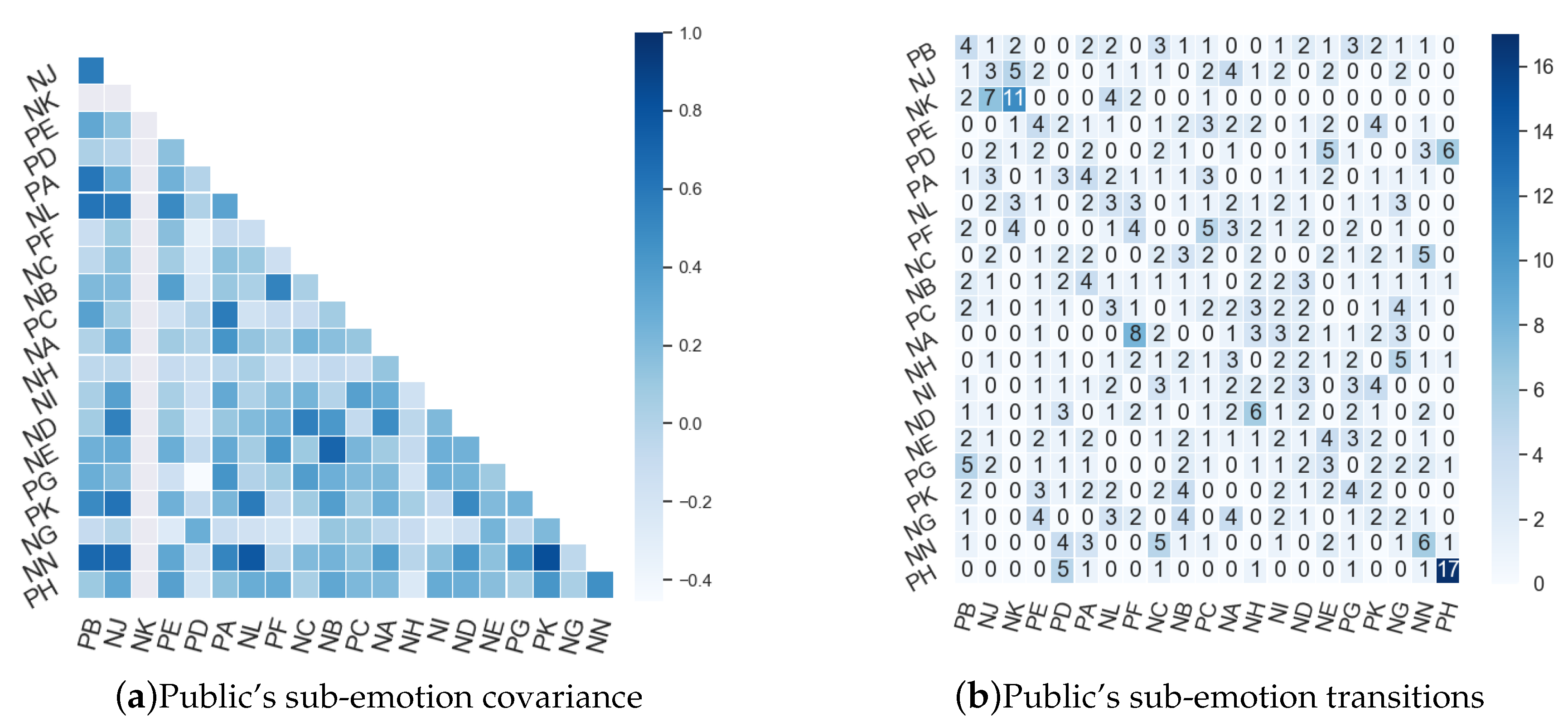
| Date | Top Hot Event of Common Users | Category | Top Hot Event of Large Users | Category |
|---|---|---|---|---|
| Before 01-21 | Isolation | Wuhan unexplained pneumonia has been isolated | ||
| 2020-01-21 | New coronavirus with potential for widespread transmission | Zhong Nanshan talks about the epidemic | ||
| 2020-01-22 | New coronavirus with potential for widespread transmission | The first new pneumonia confirmed in Henan | ||
| 2020-01-23 | New coronavirus with potential for widespread transmission | New pneumonia | ||
| 2020-01-24 | New coronavirus with potential for widespread transmission | Guangdong medical team sets off to support Wuhan on New Year’s Eve | ||
| 2020-01-25 | Medical experts help Wuhan | 138 medical staff in Sichuan help Wuhan | ||
| 2020-01-26 | 138 medical staff in Sichuan support Wuhan | Latest national epidemic map | ||
| 2020-01-27 | New coronavirus with potential for widespread transmission | 160 tons of radish from Jiangxi aid Wuhan | ||
| 2020-01-28 | A medical team of 205 people from Liaoning assists Wuhan | Caring for Wuhan | ||
| 2020-01-29 | Internet companies help Wuhan | A total of 5974 confirmed cases nationwide | ||
| 2020-01-30 | Hubei latest epidemic situation map | 9692 confirmed cases nationwide | ||
| 2020-01-31 | New pneumonia Jiangsu epidemic map | 9692 confirmed cases nationwide | ||
| 2020-02-01 | Weekly outbreak map | Li Wenliang was awarded 100,000 yuan by the charity fund | ||
| 2020-02-02 | New pneumonia outbreak map in Jiangsu | A total of 17,205 new pneumonia cases diagnosed nationwide | ||
| 2020-02-03 | A total of 14,380 confirmed cases nationwide | A total of 17,205 new pneumonia cases diagnosed nationwide | ||
| 2020-02-04 | A total of 11,794 confirmed diagnoses nationwide | Over 20,000 confirmed cases nationwide | ||
| 2020-02-05 | Experts say no new coronavirus has been found in pets or humans | Reduction of the spread of the new coronavirus to the whole country | ||
| 2020-02-06 | Guangdong epidemic map | A total of 24,324 confirmed cases nationwide | ||
| 2020-02-07 | A total of 24,324 confirmed cases nationwide | 3143 new confirmed cases nationwide | ||
| 2020-02-08 | Over 30,000 confirmed cases of new coronavirus pneumonia nationwide | National Epidemic Infected Community Map | ||
| 2020-02-09 | Experts say no new coronavirus has been found in pets and humans | Aerosol transmission may occur under special conditions of New Coronavirus | ||
| 2020-02-10 | Is it a work-related injury to be infected with new coronavirus at work? | A total of 40,171 confirmed cases nationwide | ||
| 2020-02-11 | Is it a work-related injury to be infected with new coronavirus at work? | A total of 42,638 cases of new coronavirus pneumonia diagnosed nationwide | ||
| 2020-02-12 | Aggregated outbreaks indicate that the virus has not spread to society | New cases dropped outside Hubei for 8 days | ||
| 2020-02-13 | Is it a work-related injury to be infected with new coronavirus at work? | New coronavirus pneumonia outbreak expected to end by April | ||
| 2020-02-14 | Cumulative total of 5911 cases discharged from hospital | 10 new cases drop outside Hubei | ||
| 2020-02-15 | Nine people in the same family in Beijing IV have been infected | Mr. Weekly fights COVID-19 with you | ||
| 2020-02-16 | 18 new confirmed cases in Hebei | A total of 68,500 cases of new coronavirus pneumonia diagnosed nationwide | ||
| 2020-02-17 | A total of 543 cases of new coronavirus pneumonia diagnosed in Jiangsu | Spotlight on new coronavirus pneumonia |
| Date | Top 2 Hot Events of Common Users | Category | Top 2 Hot Events of Large Users | Category |
|---|---|---|---|---|
| 2020-01-20 | epidemic | New coronavirus pneumonia included in legal infectious diseases | ||
| 2020-01-21 | epidemic | Five new cases of pneumonia confirmed in Chongqing | ||
| 2020-01-22 | isolation | Retrograde in the epidemic | ||
| 2020-01-23 | Medical experts help Wuhan | Wuhan frontline doctor consciously isolated from family | ||
| 2020-01-24 | New pneumonia nationwide real-time map | Doctor feels sick and chooses self-isolation | ||
| 2020-01-25 | Wuhan elderly couple self-isolated for New Year’s Eve | New pneumonia outbreak may improve before Lantern Festival | ||
| 2020-01-26 | Update the outbreak map in real time | 137 people from Liaoning medical team support Wuhan | ||
| 2020-01-27 | Liaoning 205 medical team assists Wuhan | Xinjiang uniformly isolates asymptomatic people | ||
| 2020-01-28 | Potential for widespread spread of new coronavirus | 1771 new diagnoses nationwide | ||
| 2020-01-29 | Wuhan New Coronavirus | Han Hong loves Wuhan | ||
| 2020-01-30 | Wuhan New Coronavirus | New pneumonia | ||
| 2020-01-31 | More than 30 drugs that may be effective against new coronavirus | Hubei Epidemic Prevention Conference | ||
| 2020-02-01 | Husband yells at nurse wife in Wuhan | A total of 17,205 new pneumonia cases diagnosed nationwide | ||
| 2020-02-02 | A total of 11,821 confirmed diagnoses nationwide | Hubei Epidemic Prevention Conference | ||
| 2020-02-03 | Feces or survival virus in new coronavirus pneumonia patients | New coronavirus survives for 5 days and is transmitted by droplets, etc. | ||
| 2020-02-04 | 6 key issues of new coronavirus | Hubei Epidemic Prevention Conference | ||
| 2020-02-05 | Fujian outbreak map | A total of 24,324 confirmed cases nationwide | ||
| 2020-02-06 | Guangdong Epidemic Prevention Conference | Difference between cold flu and new coronavirus | ||
| 2020-02-07 | Reduction of the spread of the new coronavirus to the whole country | National Health Commission expresses deep condolences to Dr. Li Wenliang | ||
| 2020-02-08 | Difference between cold flu and new coronavirus | A total of 34,546 cases of new coronavirus pneumonia diagnosed nationwide | ||
| 2020-02-09 | Over 30,000 confirmed cases of new coronavirus pneumonia nationwide | A total of 34,546 new pneumonia cases diagnosed nationwide | ||
| 2020-02-10 | Difference between cold flu and new coronavirus | New coronavirus can spread in hot, cold, humid and hot weather | ||
| 2020-02-11 | Over 30,000 confirmed cases of new coronavirus pneumonia nationwide | WHO says new coronavirus is not afraid of hot and humid weather | ||
| 2020-02-12 | New cases drop outside Hubei for seven days | Mr. Weekly fights COVID-19 with you | ||
| 2020-02-13 | Experts say no new coronavirus has been found in pets and humans | Hubei notified the latest progress of epidemic prevention and control | ||
| 2020-02-14 | Original relay to fight COVID-19 | Fight with epidemic | ||
| 2020-02-15 | Total number of cases admitted to Vulcan Mountain Hospital exceeds 1000 | Mr. Weekly fights COVID-19 with you | ||
| 2020-02-16 | Original relay to fight COVID-19 | Mr. Weekly fights COVID-19 with you | ||
| 2020-02-17 | Spotlight on new coronavirus pneumonia |
References
- Huang, C.E.A. Clinical features of patients infected with 2019 novel coronavirus in Wuhan, China. Lancet 2020, 395, 497–506. [Google Scholar] [CrossRef]
- Neubaum, G. Psychosocial functions of social media usage in a disaster situation: A multi-methodological approach. Comput. Hum. Behav. 2014, 34, 28–38. [Google Scholar] [CrossRef]
- Stokes, C.; Senkbeil, J.C. Facebook and Twitter, communication and shelter, and the 2011 Tuscaloosa tornado. Disasters 2016, 41, 194. [Google Scholar] [CrossRef] [PubMed]
- Jung, J.Y.; Moro, M. Multi-level functionality of social media in the aftermath of the Great East Japan Earthquake. Disasters 2014, 38, s123–s143. [Google Scholar] [CrossRef]
- Starbird, K.; Palen, L.; Hughes, A.L.; Vieweg, S. Chatter on the red: What hazards threat reveals about the social life of microblogged information. In Proceedings of the 2010 ACM conference on Computer Supported Cooperative Work, Savannah, GA, USA, 6–10 February 2010; pp. 241–250. [Google Scholar]
- Rivera, F.I. Cultural Mechanisms in the Exchange of Social Support Among Puerto Ricans After a Natural Disaster. Qual. Health Res. 2012, 22, 801–809. [Google Scholar] [CrossRef]
- Hong, J.Y.J.; Lee, S.; Kim, N.; Kim, J.H. Community disaster resilience and social solidarity on social media: A semantic network analysis of the Sewol ferry disaster. Inf. Res. 2018, 23, n3. [Google Scholar]
- Halse, S.; Tapia, A.; Squicciarini, A.; Caragea, C. An emotional step toward automated trust detection in crisis social media. Inf. Commun. Soc. 2017, 21, 288–305. [Google Scholar] [CrossRef]
- Shan, S.; Zhao, F.; Wei, Y.; Liu, M. Disaster management 2.0: A real-time disaster damage assessment model based on mobile social media data—A case study of Weibo (Chinese Twitter). Saf. Sci. 2019, 115, 393–413. [Google Scholar] [CrossRef]
- Yu, L.; Li, L.; Tang, L. What can mass media do to control public panic in accidents of hazardous chemical leakage into rivers? A multi-agent-based online opinion dissemination model. J. Clean Prod. 2016, 143, 1203–1214. [Google Scholar] [CrossRef]
- Bowden, D.C.; Earle, P.S.; Guy, M. Twitter earthquake detection: Earthquake monitoring in a social world. Ann. Geophys. 2011, 54, 708–715. [Google Scholar]
- Crooks, A.; Croitoru, A.; Stefanidis, A.; Radzikowski, J. #Earthquake: Twitter as a Distributed Sensor System. Trans. Gis 2013, 17, 124–147. [Google Scholar]
- Tang, L.; Bie, B.; Zhi, D. Tweeting about measles during stages of an outbreak: A semantic network approach to the framing of an emerging infectious disease. Am. J. Infect. Control 2018, 46, 871–882. [Google Scholar] [CrossRef]
- He, X.; Lin, Y.R. Measuring and monitoring collective attention during shocking events. EPJ Data Sci. 2017, 6, 30. [Google Scholar] [CrossRef]
- Rudra, K.; Sharma, A.; Ganguly, N.; Ghosh, S. Characterizing and Countering Communal Microblogs During Disaster Events. IEEE Trans. Comput. Soc. Syst. 2018, 5, 403–417. [Google Scholar] [CrossRef]
- Hua, B.; Yu, G. A Weibo-based approach to disaster informatics: Incidents monitor in post-disaster situation via Weibo text negative sentiment analysis. Nat. Hazards 2016, 83, 1177–1196. [Google Scholar]
- Shekhar, H.; Setty, S. Disaster analysis through tweets. In Proceedings of the IEEE International Conference on Advances in Computing, Kochi, India, 10–13 August 2015; pp. 1709–1713. [Google Scholar]
- Bizid, I.; Nayef, N.; Naoui, O.; Boursier, P.; Faiz, S. A Comparative Study of Microblogs Features Effectiveness for the Identification of Prominent Microblog Users During Unexpected Disaster. ISCRAM-Med 2015. [Google Scholar] [CrossRef]
- Zhyo, J.D.; Ho-Jin, C. Korean Twitter Emotion Classification Using Automatically Built Emotion Lexicons and Fine-Grained Features. In Proceedings of the 29th Pacific Asia Conference on Language, Information and Computation, Shanghai, China, 30 October–1 November 2015; pp. 142–150. [Google Scholar]
- Zheng, C.; Shen, L.; Dai, N. Chinese Microblog Emotion Classification Based on Class Sequential Rules. Comput. Eng. 2016, 194, 184–189. [Google Scholar]
- Zhou, Q.; Zhang, C.; Su, X. Emotion Evolutions of Sub-Topics About Popular Events on Microblogs. Electron. Libr. 2017, 35, 770–782. [Google Scholar] [CrossRef]
- Suttles, J.; Ide, N. Distant Supervision for Emotion Classification with Discrete Binary Values. In Proceedings of the 14th International Conference on Computational Linguistics and Intelligent Text Processing, Samos, Greece, 24–30 March 2013; pp. 121–136. [Google Scholar]
- Rao, Y.; Lei, J.; Liu, W.; Li, Q.; Chen, M. Building emotional dictionary for sentiment analysis of online news. World Wide Web 2014, 17, 723–742. [Google Scholar] [CrossRef]
- Wen, S.; Wan, X. Emotion classification in microblog texts using class sequential rules. Proc. Natl. Conf. Artif. Intell. 2014, 1, 187–193. [Google Scholar]
- Xinmiao, L.; Jing, L.; Yukeng, W.; Wen-Bo, D. A global optimization approach to multi-polarity sentiment analysis. PLoS ONE 2015, 10, e0124672. [Google Scholar]
- Peng, H.; Ma, Y.; Li, Y.; Cambria, E. Learning multi-grained aspect target sequence for Chinese sentiment analysis. Knowl. Based Syst. 2018, 148, 167–176. [Google Scholar] [CrossRef]
- Singh, N.; Roy, N.; Gangopadhyay, A. Analyzing the Sentiment of Crowd for Improving the Emergency Response Services. In Proceedings of the 2018 IEEE International Conference on Smart Computing (SMARTCOMP), Taormina, Italy, 18–20 June 2018; pp. 1–8. [Google Scholar]
- Gaspar, R.; Pedro, C.; Panagiotopoulos, P.; Seibt, B. Beyond positive or negative: Qualitative sentiment analysis of social media reactions to unexpected stressful events. Comput. Hum. Behav. 2016, 56, 179–191. [Google Scholar] [CrossRef]
- Hyekyung, W.; Youngtae, C.; Eunyoung, S.; Kihwang, L.; Gilyoung, S. Public Trauma after the Sewol Ferry Disaster: The Role of Social Media in Understanding the Public Mood. Int. J. Environ. Res. Public Health 2015, 12, 10974–10983. [Google Scholar]
- Teodorescu, H.N. SN voice and text analysis as a tool for disaster effects estimation—A preliminary exploration. In Proceedings of the Speech Technology and Human-computer Dialogue, Cluj-Napoca, Romania, 16–19 October 2013. [Google Scholar]
- Brummette, J.; Fussell Sisco, H. Using Twitter as a means of coping with emotions and uncontrollable crises. Public Relations Rev. 2015, 41, 89–96. [Google Scholar] [CrossRef]
- Neppalli, V.K.; Caragea, C.; Squicciarini, A.; Tapia, A.; Stehle, S. Sentiment analysis during Hurricane Sandy in emergency response. Int. J. Disaster Risk Reduct. 2017, 21, 213–222. [Google Scholar] [CrossRef]
- Mandel, B.; Culotta, A.; Boulahanis, J.; Stark, D.; Lewis, B.; Rodrigue, J. A Demographic Analysis of Online Sentiment during Hurricane Irene. In Proceedings of the Second Workshop on Language in Social Media, Montreal, QC, Canada, 3–8 June 2012; pp. 27–36. [Google Scholar]
- Wendy, M.; Karen, H.; Vicki, F. Blog Functions as Risk and Crisis Communication During Hurricane Katrina. J. Comput. Mediat. Commun. 2010, 15, 1–31. [Google Scholar]
- Zhang, W.; Zhu, Y.C.; Wang, J.P. An intelligent textual corpus big data computing approach for lexicons construction and sentiment classification of public emergency events. Multimed. Tools Appl. 2018, 78, 30159–30174. [Google Scholar] [CrossRef]
- Guo, S.J.; Jiankun, S. The 2013 Boston marathon bombing: Publics’ emotions, coping, and organizational engagement. Public Relations Rev. 2017, 43, 755–767. [Google Scholar] [CrossRef]
- Lin, Y.R.; Margolin, D.; Wen, X. Tracking and Analyzing Individual Distress Following Terrorist Attacks Using Social Media Streams. Risk Anal. 2017, 37, 1580. [Google Scholar] [CrossRef]
- Meadows, C.W.; Meadows, C.Z.; Tang, L.; Liu, W. Unraveling Public Health Crises Across Stages: Understanding Twitter Emotions and Message Types During the California Measles Outbreak. Commun. Stud. 2019, 70, 453–469. [Google Scholar] [CrossRef]
- Tengfei, Y.; Xie, J.; Li, G.; Mou, N.; Li, Z.; Chuanzhao, T.; Zhao, J. Social Media Big Data Mining and Spatio-Temporal Analysis on Public Emotions for Disaster Mitigation. ISPRS Int. J. Geo Inf. 2019, 8, 29. [Google Scholar]
- Giuntini, F.T.; Ruiz, L.P.; Kirchner, L.D.F.; Passarelli, D.A.; Dos Reis, M.D.J.D.; Campbell, A.T.; Ueyama, J. How Do I Feel? Identifying Emotional Expressions on Facebook Reactions Using Clustering Mechanism. IEEE Access 2019, 7, 53909–53921. [Google Scholar] [CrossRef]
- Zhang, D.; Lin, H.; Yang, L.; Zhang, S.; Xu, B. Construction of a Chinese Corpus for the Analysis of the Emotionality of Metaphorical Expressions. In Proceedings of the 56th Annual Meeting of the Association for Computational Linguistics, Melbourne, Australia, 15–20 July 2018; pp. 144–150. [Google Scholar]
- Ekman, P. Universals and cultural differences in facial expressions of emotion. J. Personal. Soc. Psychol. 1987, 53, 712–717. [Google Scholar] [CrossRef]
- Ren, F.; Kang, X.; Quan, C. Examining Accumulated Emotional Traits in Suicide Blogs with an Emotion Topic Model. IEEE J. Biomed. Health Inf. 2016, 20, 1384–1396. [Google Scholar] [CrossRef]
- Griffin, R.J.; Neuwirth, K.; Dunwoody, S.; Giese, J. Information Sufficiency and Risk Communication. Media Psychol. 2004, 6, 23–61. [Google Scholar] [CrossRef]
- Choi, Y.; Lin, Y.H. Consumer Responses to Mattel Product Recalls Posted on Online Bulletin Boards: Exploring Two Types of Emotion. J. Public Relat. Res. 2009, 21, 198–207. [Google Scholar] [CrossRef]
- Gongora-Coronado, E.A.; Vásquez-Velázquez, I.I. From Coping with Stress to Positive Coping with Life: Theoretical Review and Application. Psychology 2018, 9, 2909–2932. [Google Scholar] [CrossRef]
- Folkman, S.; Moskowitz, J.T. Stress, positive emotion, and coping. Curr. Dir. Psychol. Sci. 2000, 9, 115–118. [Google Scholar] [CrossRef]
- Fredrickson, B.L.; Tugade, M.M.; Waugh, C.E.; Larkin, G.R. What good are positive emotions in crisis? A prospective study of resilience and emotions following the terrorist attacks on the United States on September 11th, 2001. J. Personal. Soc. Psychol. 2003, 84, 365–376. [Google Scholar] [CrossRef]
- Fredrickson, B.L.; Joiner, T. Positive emotions trigger upward spirals toward emotional well-being. Psychology 2002, 13, 172–175. [Google Scholar] [CrossRef] [PubMed]
- Kim, H.K.; Niederdeppe, J. The Role of Emotional Response during an H1N1 Influenza Pandemic on a College Campus. J. Public Relat. Res. 2013, 25, 30–50. [Google Scholar] [CrossRef]
- Jin, Y. Making Sense Sensibly in Crisis Communication: How Publics’ Crisis Appraisals Influence Their Negative Emotions, Coping Strategy Preferences, and Crisis Response Acceptance. Commun. Res. 2010, 37, 522–552. [Google Scholar] [CrossRef]
- Liu, B.F.; Austin, L.; Jin, Y. How publics respond to crisis communication strategies: The interplay of information form and source. Public Relat. Rev. 2011, 37, 345–353. [Google Scholar] [CrossRef]
- Taylor, M.; Wells, G.; Howell, G.; Raphael, B. The role of social media as psychological first aid as a support to community resilience building. Aust. J. Emerg. Manag. 2012, 27, 20–26. [Google Scholar]
- Norris, F.; Stevens, S.; Pfefferbaum, B.; Wyche, K.F.; Pfefferbaum, R.L. Community Resilience as a Metaphor, Theory, Set of Capacities, and Strategy for Disaster Readiness. Am. J. Commun. Psychol. 2008, 4, 127–150. [Google Scholar] [CrossRef]
- Collins, R. Rituals of Solidarity and Security in the Wake of Terrorist Attack. Sociol. Theory 2004, 22, 53–87. [Google Scholar] [CrossRef]
- James, H.; John, R. Social Relations that Generate and Sustain Solidarity after a Mass Tragedy. Soc. Forces 2011, 89, 1363–1384. [Google Scholar]
- Paton, D. Disaster Resilience: An Integrated Approach; Charles C Thomas Publisher: Springfield, IL, USA, 2006. [Google Scholar]
- Council, N.R. Applications of Social Network Analysis for Building Community Disaster Resilience: Workshop Summary; National Academies Press: Washington, DC, USA, 2009. [Google Scholar]
- Silver, H. Social Exclusion and Social Solidarity: Three Paradigms. Int. Labour Rev. 1994, 133, 531. [Google Scholar]
- Drury, J.; Brown, R.; Gonzalez, R.; Miranda, D. Emergent social identity and observing social support predict social support provided by survivors in a disaster: Solidarity in the 2010 Chile earthquake. Eur. J. Soc. Psychol. 2016, 46, 209–223. [Google Scholar] [CrossRef]
- Bharti, S.K.; Babu, K.S.; Jena, S.K. Parsing-based Sarcasm Sentiment Recognition in Twitter Data. In Proceedings of the Advances in Social Networks Analysis and Mining, Paris, France, 25 August 2015. [Google Scholar]
- Katragadda, H.R.; Borikar, D.A. User Mood Prediction on Twitter Network with Sarcasm Detection. J. Eng. Appl. Sci. 2017, 12, 8025–8029. [Google Scholar]
- Shubhadeep, M.; Bala, P.M. Sarcasm detection in microblogs using Naive Bayes and fuzzy clustering. Technol. Soc. 2017, 48, 19–27. [Google Scholar]
- Sonawane, S.S.; Kolhe, S.R. TCSD: Term Co-occurrence Based Sarcasm Detection from Twitter Trends. Procedia Comput. Sci. 2020, 167, 830–839. [Google Scholar] [CrossRef]
- Farias, D.I.H. Irony and sarcasm detection in twitter: The role of affective content. Univ. Politecina Valencia 2017. [Google Scholar] [CrossRef]
- González-Ibánez, R.; Muresan, S.; Wacholder, N. Identifying Sarcasm in Twitter: A Closer Look. In Proceedings of the Meeting of the Association for Computational Linguistics: Human Language Technologies: Short Papers, Portland, Oregon, USA, 25 February 2011. [Google Scholar]
- Dan, J.; Jieqi, T. Study of Bot detection on Sina-Weibo based on machine-learning. In Proceedings of the 2017 14th International Conference on Service Systems and Service Management (ICSSSM), Dalian, China, 16–18 June 2017. [Google Scholar]
- Liu, Y.; Pan, J.; Hu, H. Discriminating bot accounts based solely on temporal features of microblog behavior. Phys. Stat. Mech. Appl. 2016, 450, 193–204. [Google Scholar]
- Chu, Z.; Gianvecchio, S.; Wang, H.; Jajodia, S. Detecting Automation of Twitter Accounts: Are You a Human, Bot, or Cyborg? IEEE Trans. Dependable Secur. Comput. 2012, 9, 811–824. [Google Scholar] [CrossRef]
- Clark, E.M.; Williams, J.R.; Jones, C.A.; Galbraith, R.A.; Danforth, C.M.; Dodds, P.S. Sifting Robotic from Organic Text: A Natural Language Approach for Detecting Automation on Twitter. J. Comput. Sci. 2016, 16, 1–7. [Google Scholar] [CrossRef]
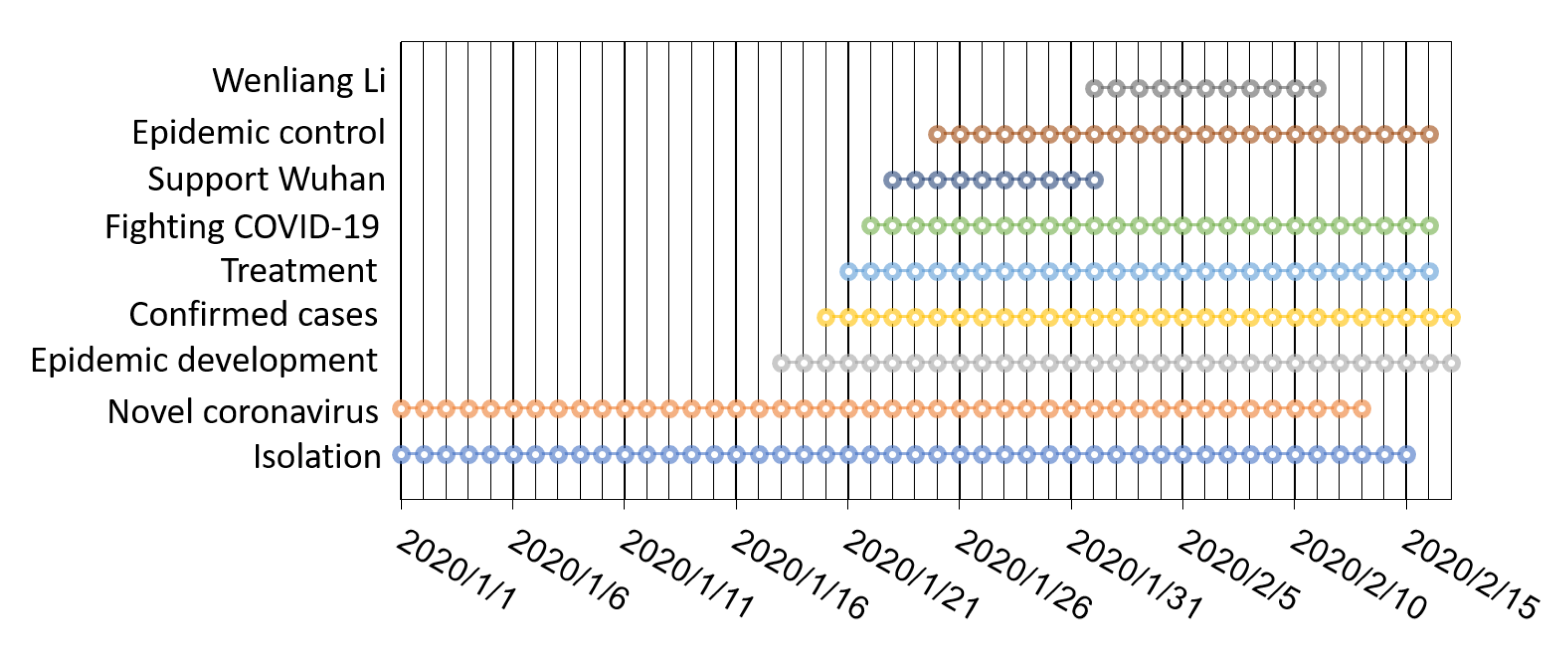
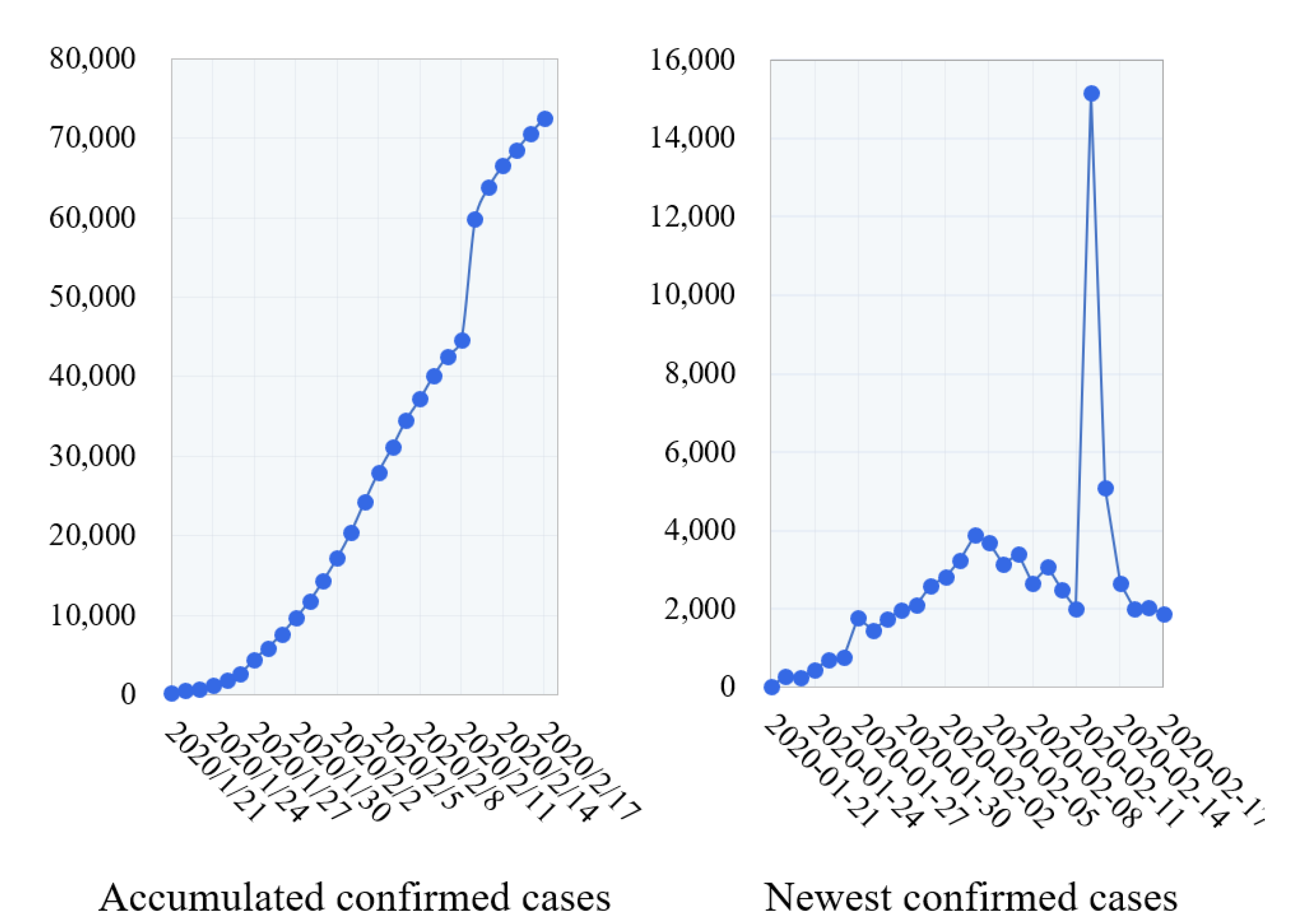
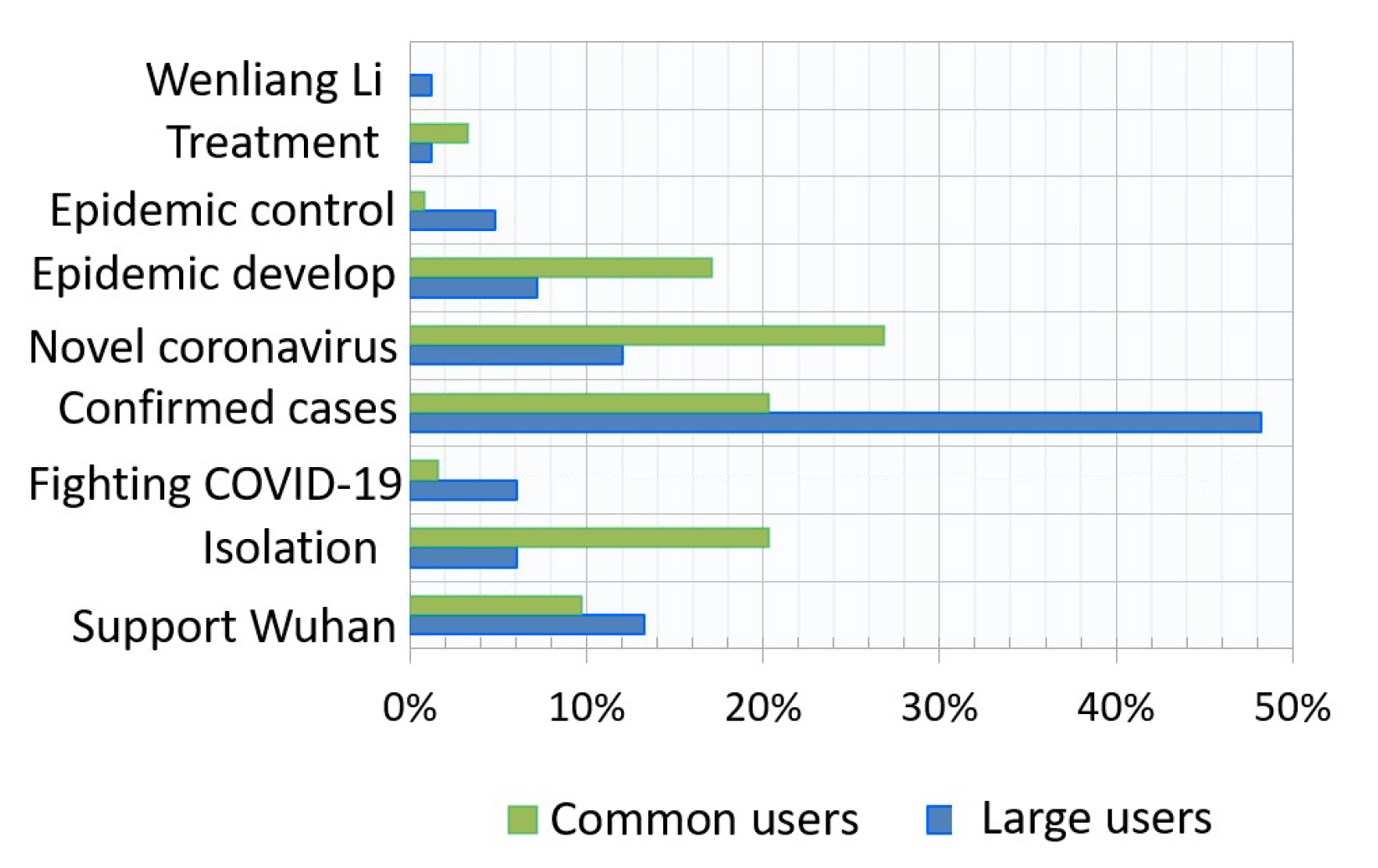
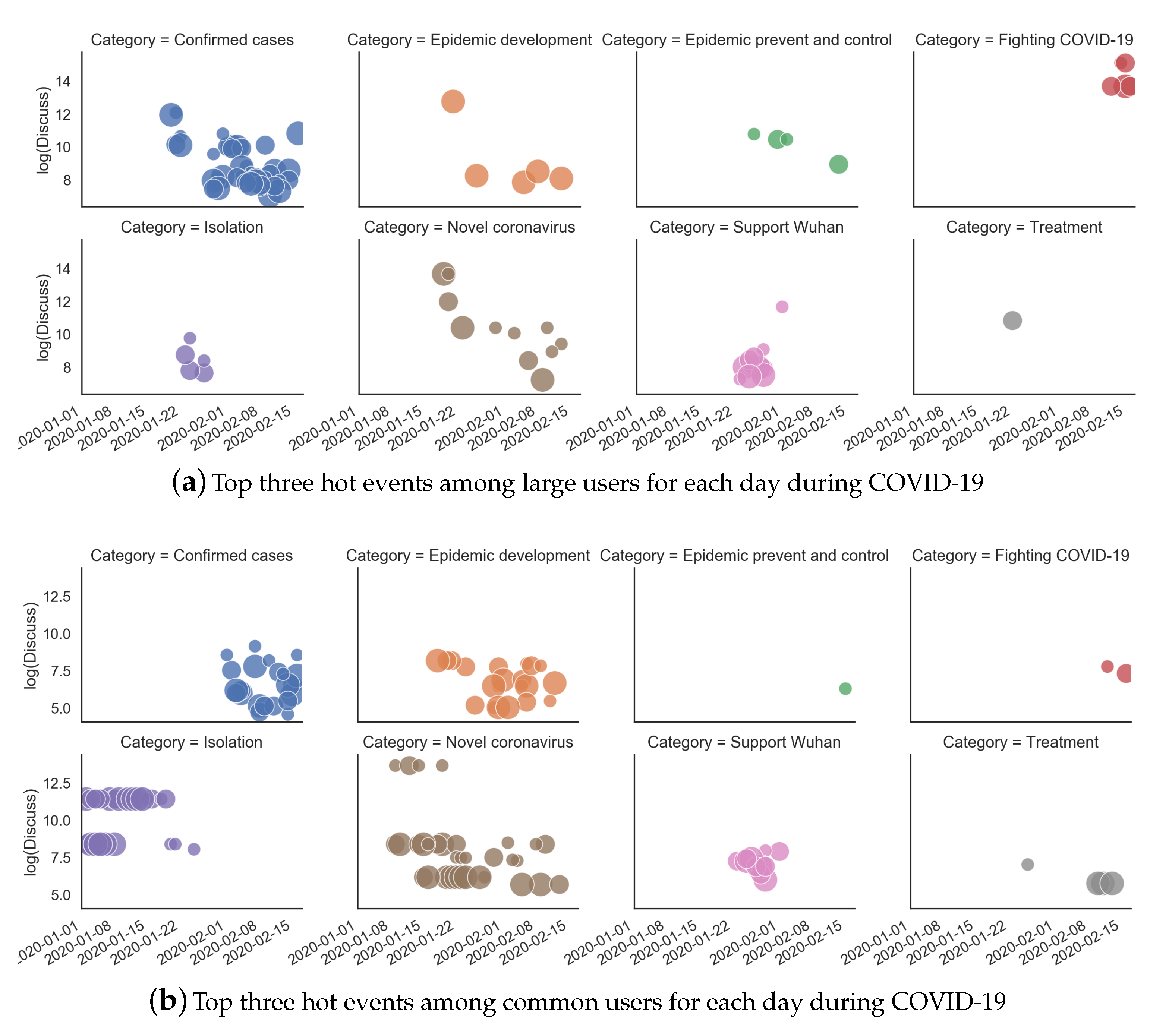
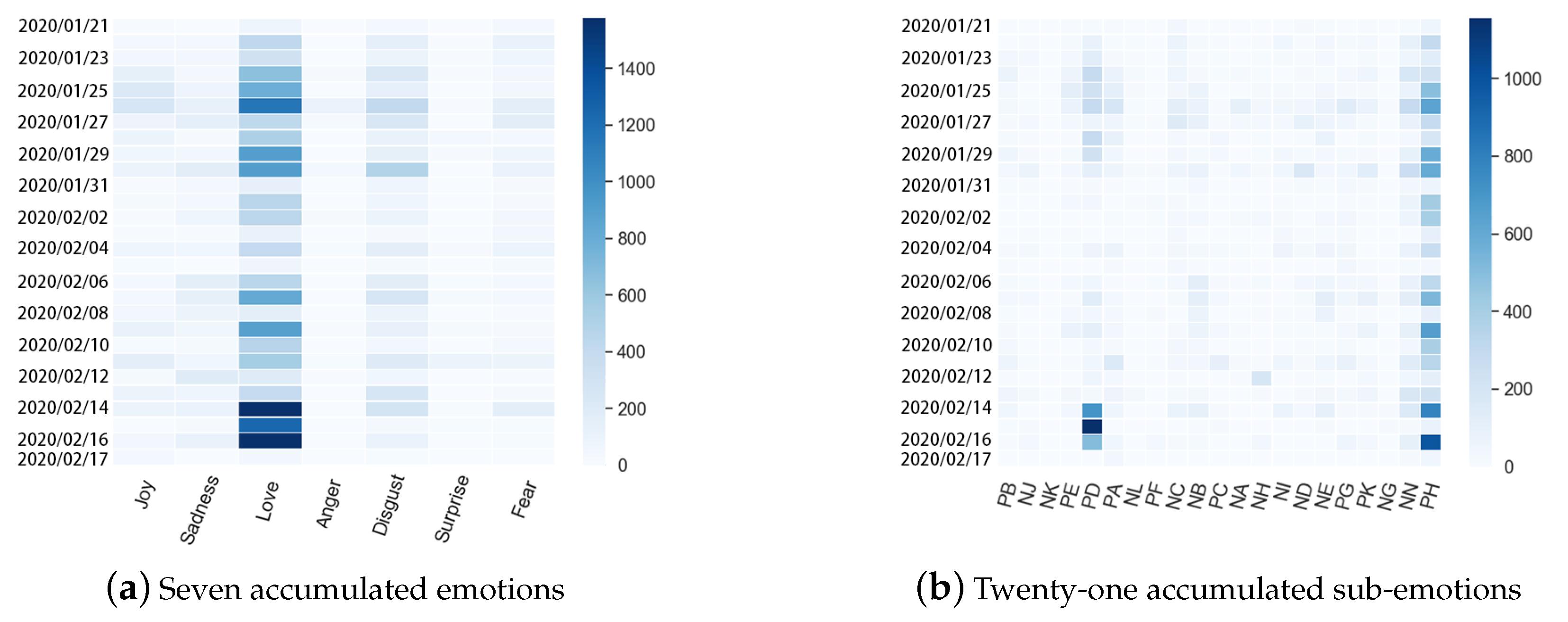
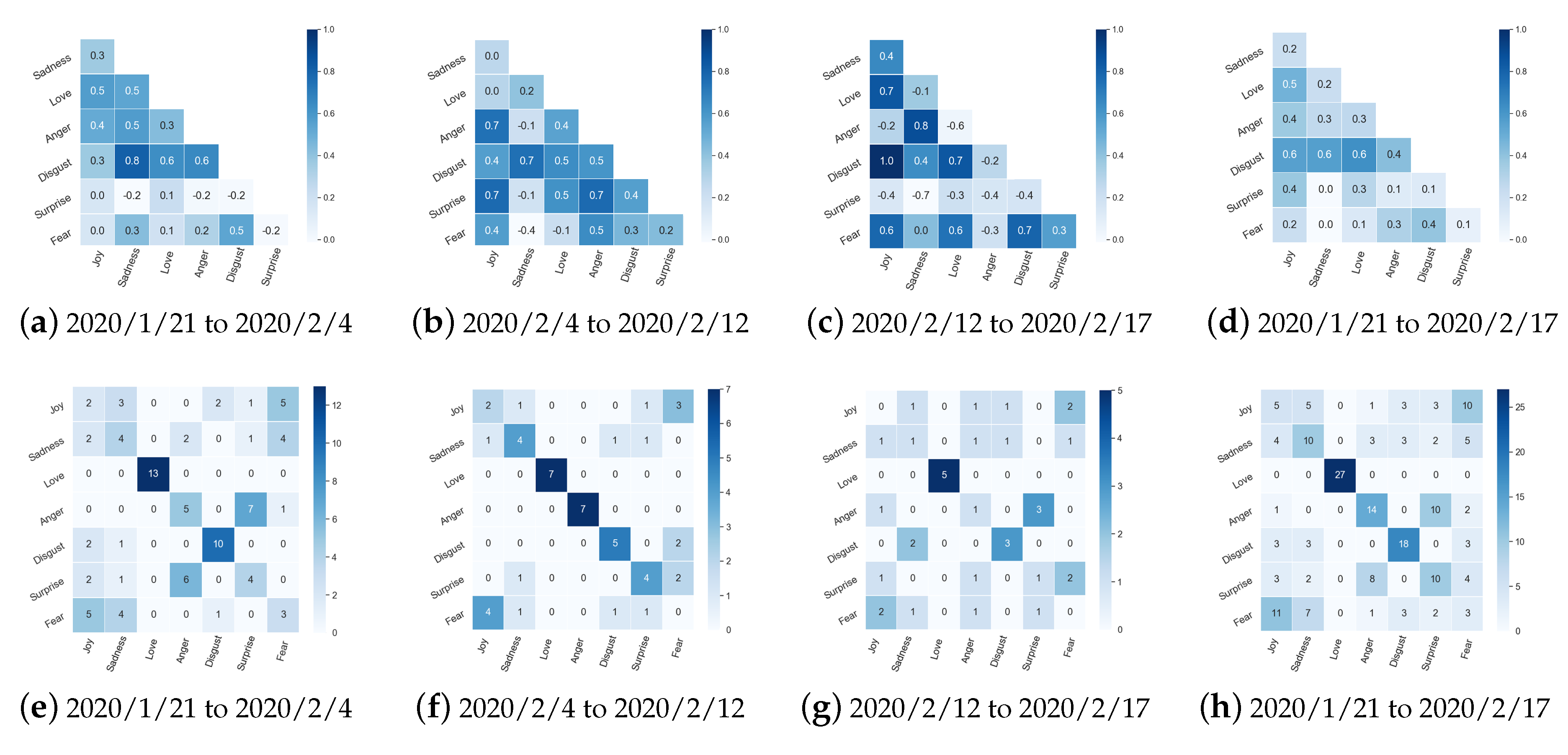
| Platform | Emotion Types | Public Emotion | Crisis Related | Emotion Evolution | Method | Literature |
|---|---|---|---|---|---|---|
| Korean Twitter | Ekman’s six emotion types | No | No | No | Machine-learning | [19] |
| Plutchik’s “wheel of emotions” | No | No | No | Machine-learning | [22] | |
| Chinese microblog | Positive, negative | No | No | No | Machine-learning | [20] |
| Chinese microblog | Anger, disgust, fear, happiness, like, sadness, or surprise | No | No | No | Rule based | [24] |
| Chinese and English news corpus | Ekman’s six emotion types | No | No | No | Rule based | [23] |
| Ekman’s six emotion types | Yes | No | No | Machine-learning | [40] | |
| Chinese reviews corpus | Positive, negative | Yes | No | No | Machine-learning | [25] |
| Chinese and English reviews corpus | Positive, negative, neural | Yes | No | No | Deep-learning | [26] |
| Plutchik’s “wheel of emotions” | Yes | Las Vegas shooting | No | Lexicon based | [27] | |
| Positive, negative, threat | Yes | EHEC incident | No | Manual coding | [28] | |
| Chinese news corpus | Positive, negative, threat | Yes | Hazardous chemical leakage | No | Rule based | [10] |
| Chinese microblog | Positive, negative | Yes | Tianjin explosion, Typhoon Nepartak | No | Lexicon based | [9] |
| Negative (unhappy, depressed, angry) and positive | Yes | Yes | No | Machine-learning | [17] | |
| Worry, irrelevant | Yes | Hurricane Irene | No | Machine-learning | [33] | |
| Anger, anxiety, sadness | Yes | Sewol ferry disaster | No | Inductive methods | [29] | |
| Messages | Sadness, joy, anger, fear, and desperation | Yes | Yes | No | Rule based | [30] |
| Anger, fright, anxiety, and sadness | Yes | 2007 Virginia Tech shooting | No | Manual coding | [31] | |
| Blogs, news | Concern, disgust, anger, fear, and hope | Yes | Hurricane Katrina | No | Manual coding | [34] |
| Ekman’s six emotions, neutral, irrelevant | Yes | Hurricane Sandy, Boston bombings | No | Online survey | [8] | |
| Positive | Yes | Boston Marathon bombing | Yes | Inductive methods | [36] | |
| Chinese microblog | Happiness, anger, fear, sadness, and surprise | Yes | H7N9 | Yes | Machine-learning | [21] |
| Chinese microblog | happy, sad, fearful, disgusted | Yes | RYBKindergarten Child Abuse | Yes | Deep-learning | [35] |
| Chinese microblog | Positive, negative | Yes | Ya’an earthquake | Yes | Machine-learning | [16] |
| Korean Naver blog | Sympathy, positive, hope | Yes | Sewol ferry disaster | Yes | Inductive methods | [7] |
| Anger, anxiety, and sadness | Yes | Yes | Yes | Rule based | [37] | |
| Chinese microblog | Anger, anxiousness, fear, and sadness | Yes | Ya’an earthquake | Yes | Deep-learning | [39] |
| Alarm/concern, reassurance, anger, humor/sarcasm, neutral | Yes | 2015 California measles | Yes | Inductive methods | [38] |
| Data and Cleaning Process | No. of Super Topics | No. of Users | No. of Microblogs | Post Date |
|---|---|---|---|---|
| 585 | 37,108 | 93,840 | - | |
| 95 | 3,783 | 32,217 | 1 December 2019–17 February | |
| filtered by time | 678 | 40,710 | 126,055 | 1 December 2019–17 February |
| filtered by topic | 326 | 39,025 | 125,672 | 1 December 2019–17 February |
| Category | No. of Super Topics | No. of Microblogs | Duration (Days) | Examples of Super Topics |
|---|---|---|---|---|
| 1. Fighting COVID-19 | 6 | 6431 | 25 | #Fight the coronavirus together# |
| #Fighting new pneumonia we are in action# | ||||
| 2. Novel coronavirus | 31 | 11,231 | 49 | #6 key issues of new coronavirus# |
| #Source of new coronavirus is wildlife# | ||||
| 3. Wenliang Li | 28 | 5477 | 10 | #Who remembers Li Wenliang# |
| #Li Wenliang dies of new pneumonia# | ||||
| 4. Treatment | 10 | 2784 | 26 | #34 cases of new pneumonia have been cured# |
| #Tribute to front line health care workers# | ||||
| 5. Epidemic development | 33 | 12,048 | 30 | #Latest national epidemic map# |
| #The epidemic is still spreading# | ||||
| 6. Confirmed cases | 166 | 68,555 | 28 | #A total of 14,380 confirmed cases nationwide# |
| #1280 new cases of new pneumonia nationwide# | ||||
| 7. Support Wuhan | 30 | 5197 | 9 | #Japan donates 1 million masks to help Wuhan# |
| #A medical team of 1230 people assists Wuhan# | ||||
| 8. Isolation | 16 | 3084 | 76 | #333 passengers in Thailand from Nanjing were isolated# |
| 9. Epidemic control | 8 | 3663 | 22 | #Beijing Epidemic Prevention and Control Conference# |
| Large users | C1 | C2 | C3 | C4 | C5 | C6 | C7 | C8 | C9 |
| Mean No. of retweets | 27,375 | 7361 | 26,236 | 5824 | 6289 | 3119 | 6000 | 6964 | 7438 |
| Mean No. of comments | 11,479 | 5301 | 28,308 | 7041 | 5558 | 7350 | 8840 | 5779 | 5818 |
| Mean No. of likes | 76,789 | 136,685 | 298,206 | 192,633 | 137,032 | 143,591 | 178,286 | 123,502 | 172,849 |
| Mean No. of topic discussions | 4 M | 386,670 | 402,573 | 1,428,090 | 579,354 | 30,524 | 558,878 | 61,340 | 74,951 |
| Mean No. of topic reads | 5.8 B | 1.6 B | 712 M | 696 M | 2.9 B | 267 M | 2.9 B | 227 M | 203 M |
| Common users | C1 | C2 | C3 | C4 | C5 | C6 | C7 | C8 | C9 |
| Mean No. of retweets | 26 | 9 | 9 | 7 | 8 | 3 | 6 | 8 | 5 |
| Mean No. of comments | 26 | 13 | 20 | 7 | 13 | 13 | 10 | 16 | 9 |
| Mean No. of likes | 208 | 127 | 179 | 77 | 133 | 36 | 103 | 120 | 126 |
| Mean No. of topic discussions | 3.7 M | 97,982 | 268,376 | 925,573 | 201,429 | 21,038 | 139,103 | 57,291 | 52,052 |
| Mean No. of topic reads | 4.2 B | 440 M | 460 M | 600 M | 1.1 B | 190 M | 750 M | 200 M | 130 M |
© 2020 by the authors. Licensee MDPI, Basel, Switzerland. This article is an open access article distributed under the terms and conditions of the Creative Commons Attribution (CC BY) license (http://creativecommons.org/licenses/by/4.0/).
Share and Cite
Li, Q.; Wei, C.; Dang, J.; Cao, L.; Liu, L. Tracking and Analyzing Public Emotion Evolutions During COVID-19: A Case Study from the Event-Driven Perspective on Microblogs. Int. J. Environ. Res. Public Health 2020, 17, 6888. https://doi.org/10.3390/ijerph17186888
Li Q, Wei C, Dang J, Cao L, Liu L. Tracking and Analyzing Public Emotion Evolutions During COVID-19: A Case Study from the Event-Driven Perspective on Microblogs. International Journal of Environmental Research and Public Health. 2020; 17(18):6888. https://doi.org/10.3390/ijerph17186888
Chicago/Turabian StyleLi, Qi, Cong Wei, Jianning Dang, Lei Cao, and Li Liu. 2020. "Tracking and Analyzing Public Emotion Evolutions During COVID-19: A Case Study from the Event-Driven Perspective on Microblogs" International Journal of Environmental Research and Public Health 17, no. 18: 6888. https://doi.org/10.3390/ijerph17186888
APA StyleLi, Q., Wei, C., Dang, J., Cao, L., & Liu, L. (2020). Tracking and Analyzing Public Emotion Evolutions During COVID-19: A Case Study from the Event-Driven Perspective on Microblogs. International Journal of Environmental Research and Public Health, 17(18), 6888. https://doi.org/10.3390/ijerph17186888





